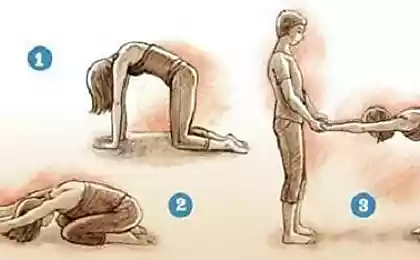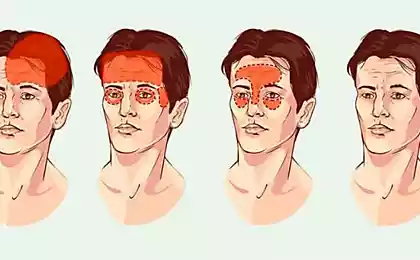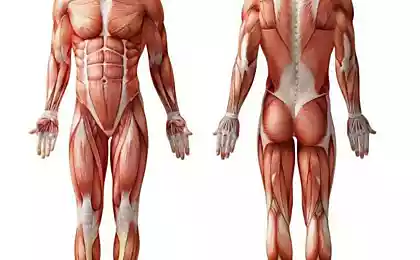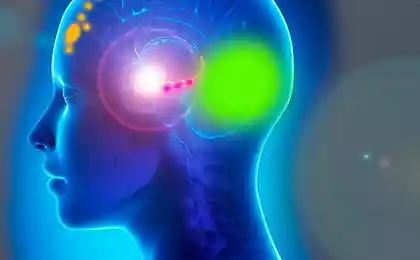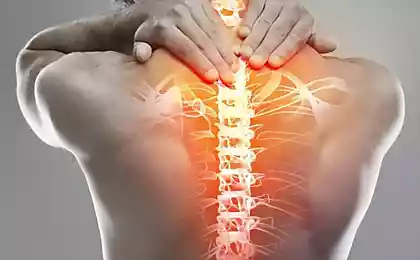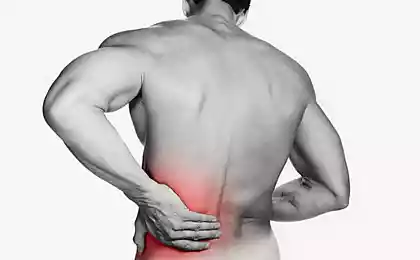513
How to recognize the syndromes of the spine osteochodrosis
For osteochondrosis of different localization characteristic complex of symptoms combined into syndromes.
For example, for the cervical spine is cervicalgia.
Syndrome cervicalgia is often the first manifestation of degenerative disc disease of the cervical spine. Manifested pain of various kind, which is associated with predominant lesions of the autonomic nerve fibers.

Pain in upper cervical usually indicate violations in the area of the occipital-cervical transition, and in srednekan — functional blockages in the PDS C3.6. Most of the blockade of the cervical PDS do not appear local pain and a violation of the mobility of the shoulder joints, which is restored after manipulation of the cervical spine (K. Levitt, 1975).
In addition, reflex changes in the shoulder region can occur if closures verhnesheynye PDS.
Cervicobrachialgia is sympathetic zadnesheynyh syndrome, or syndrome of the vertebral artery, described in 1925 Barre, and then in 1928 Liu.
Infringement of meniscoid for closure of PDS and resulting circulatory disorders and innervation in the area of PDS play a significant role in the formation of this syndrome. This is due to the proximity of the passage of the vertebral artery from the facet joints, especially in the upper cervical and involvement of the cervical sympathetic trunk and spinal nerves that Innervate the facet joints, in the formation of the spinal nerve (T. V. Zolotareva, T. A. Dashuk, 1980).
For the clinical picture of the specified syndrome is characterized by the presence of pain in the neck and nape, extending to the parietal, occipital and frontal region of the head. The pain is accompanied by dizziness, nausea, tinnitus, unpleasant sensations in the heart region and palpitation. Dizziness may be accompanied by nausea and vomiting; they are significantly amplified when you change the position of the head, especially when tilting it. These symptoms are more pronounced head movements.
The disease is often accompanied by emotional and autonomic lability, General weakness and increased fatigability.
In this condition, particular attention should be paid verhnesheynye the spine, pain in the occipital region often linked to blockades of the cervical-thoracic transition (PDS Q-T).
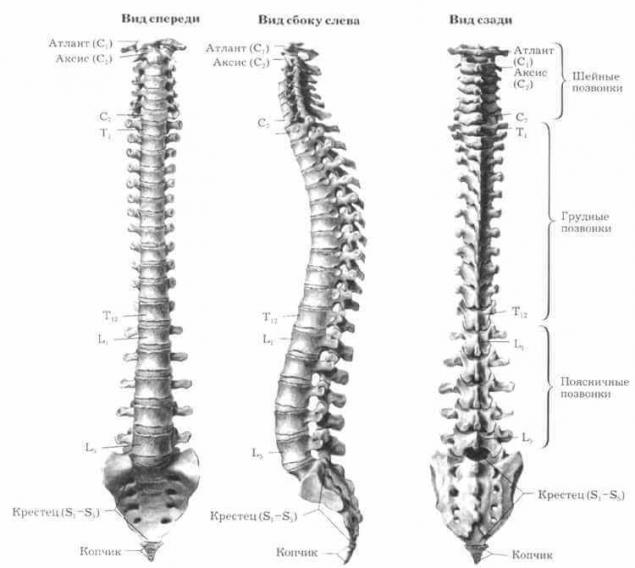
Cervicobrachialgia. Manifestations of pathology of the spine applies such vertebrogenic disease syndrome brachialgia, or frozen shoulder syndrome.
In the literature (K. Lewit, 1975; E. Rychlikova, 1980) we can distinguish the following most common variants of brachialgia:
1. Brachialgia related to disorders of the cervical spine. Is manifested by pain in the cervical covering for the upper body and all arms and accompanied by some limitation of motion of the shoulder joint.
The mobility of the hands improved significantly after manual recovery of the function of the cervical spine using manipulation or mobilization postisometric relaxation.
2. Brachialgia that begins with the onset of pain in the neck and flows by type of cervicalgia. Then join pain in the shoulder joint, accompanied by the restriction of his mobility, especially in abduction of the hand. In a further variant of frozen shoulder syndrome occurs independently and the correction function of the cervical has no significant effect on it.
3. Brachialgia, with pain and limitation of movements are usually more pronounced in one plane, occur suddenly due to sudden movements or marked in the morning after sleep. The basis of this variant of development is the blockade of the shoulder joint, so the manipulation of the joint in most cases leads to complete recovery of the patient.
4. Frozen shoulder is a specific disease of the shoulder joint, characterized by restriction of movement. It has a typical clinical picture and course. Sick often individuals aged 40 to 60 years. The clinical course is usually divided into three stages:
5. Brachialgia related to lose reberno-transverse joints at the level of III—V ribs. For this kind of brachialgia typically the presence of pain expressed vegetative character, which apparently is due to the close proximity of the sympathetic trunk and capsules costal-transverse joints. Patients complain of aching pain, often at night, sometimes there is numbness in the posterior surface of the arm and forearm. Movement in the shoulder joint somewhat painful but not limited.
Mobilization of the rib-transverse joints and the impact on areas of local increased tone in the muscles, levator scapulae, using the techniques of massage and post isometric relaxation significantly reduce pain. published
From the book T. V. Lukyanenko "a Healthy spine. Recipes and recommendations"
Also interesting: How cervical osteochondrosis influence on our state
Cervical osteochondrosis— treatment of folk remedies
Source: vk.com/wall-23903469?w=wall-23903469_1069
For example, for the cervical spine is cervicalgia.
Syndrome cervicalgia is often the first manifestation of degenerative disc disease of the cervical spine. Manifested pain of various kind, which is associated with predominant lesions of the autonomic nerve fibers.

Pain in upper cervical usually indicate violations in the area of the occipital-cervical transition, and in srednekan — functional blockages in the PDS C3.6. Most of the blockade of the cervical PDS do not appear local pain and a violation of the mobility of the shoulder joints, which is restored after manipulation of the cervical spine (K. Levitt, 1975).
In addition, reflex changes in the shoulder region can occur if closures verhnesheynye PDS.
Cervicobrachialgia is sympathetic zadnesheynyh syndrome, or syndrome of the vertebral artery, described in 1925 Barre, and then in 1928 Liu.
Infringement of meniscoid for closure of PDS and resulting circulatory disorders and innervation in the area of PDS play a significant role in the formation of this syndrome. This is due to the proximity of the passage of the vertebral artery from the facet joints, especially in the upper cervical and involvement of the cervical sympathetic trunk and spinal nerves that Innervate the facet joints, in the formation of the spinal nerve (T. V. Zolotareva, T. A. Dashuk, 1980).
For the clinical picture of the specified syndrome is characterized by the presence of pain in the neck and nape, extending to the parietal, occipital and frontal region of the head. The pain is accompanied by dizziness, nausea, tinnitus, unpleasant sensations in the heart region and palpitation. Dizziness may be accompanied by nausea and vomiting; they are significantly amplified when you change the position of the head, especially when tilting it. These symptoms are more pronounced head movements.
The disease is often accompanied by emotional and autonomic lability, General weakness and increased fatigability.
In this condition, particular attention should be paid verhnesheynye the spine, pain in the occipital region often linked to blockades of the cervical-thoracic transition (PDS Q-T).

Cervicobrachialgia. Manifestations of pathology of the spine applies such vertebrogenic disease syndrome brachialgia, or frozen shoulder syndrome.
In the literature (K. Lewit, 1975; E. Rychlikova, 1980) we can distinguish the following most common variants of brachialgia:
1. Brachialgia related to disorders of the cervical spine. Is manifested by pain in the cervical covering for the upper body and all arms and accompanied by some limitation of motion of the shoulder joint.
The mobility of the hands improved significantly after manual recovery of the function of the cervical spine using manipulation or mobilization postisometric relaxation.
2. Brachialgia that begins with the onset of pain in the neck and flows by type of cervicalgia. Then join pain in the shoulder joint, accompanied by the restriction of his mobility, especially in abduction of the hand. In a further variant of frozen shoulder syndrome occurs independently and the correction function of the cervical has no significant effect on it.
3. Brachialgia, with pain and limitation of movements are usually more pronounced in one plane, occur suddenly due to sudden movements or marked in the morning after sleep. The basis of this variant of development is the blockade of the shoulder joint, so the manipulation of the joint in most cases leads to complete recovery of the patient.
4. Frozen shoulder is a specific disease of the shoulder joint, characterized by restriction of movement. It has a typical clinical picture and course. Sick often individuals aged 40 to 60 years. The clinical course is usually divided into three stages:
- I stage — lasts from 2 to 4 months and is characterized by a gradual increase in pain and progressive limitation of joint mobility in all planes. The pain reaches a significant intensity.
- Stage II — usually lasts 2 to 3 months and is characterized by a gradual decrease in pain, but joint mobility is limited, and only at the end of this period, there are signs of improvement.
- Stage III — lasts 2-5 months and is characterized by gradual restoration of mobility in the joint. Pain in this stage is usually absent. After recovery for a long time, there may be some limitation in the joint.
5. Brachialgia related to lose reberno-transverse joints at the level of III—V ribs. For this kind of brachialgia typically the presence of pain expressed vegetative character, which apparently is due to the close proximity of the sympathetic trunk and capsules costal-transverse joints. Patients complain of aching pain, often at night, sometimes there is numbness in the posterior surface of the arm and forearm. Movement in the shoulder joint somewhat painful but not limited.
Mobilization of the rib-transverse joints and the impact on areas of local increased tone in the muscles, levator scapulae, using the techniques of massage and post isometric relaxation significantly reduce pain. published
From the book T. V. Lukyanenko "a Healthy spine. Recipes and recommendations"
Also interesting: How cervical osteochondrosis influence on our state
Cervical osteochondrosis— treatment of folk remedies
Source: vk.com/wall-23903469?w=wall-23903469_1069
The study will allow to increase the safety of lithium batteries to a new level
The water tower in the country: what you need to know





